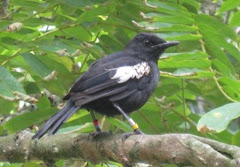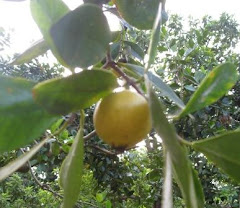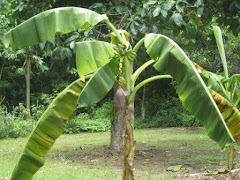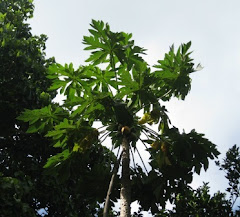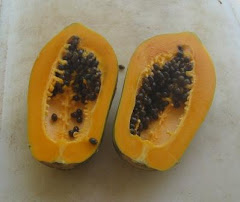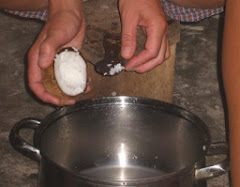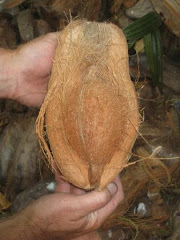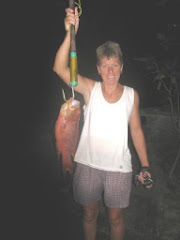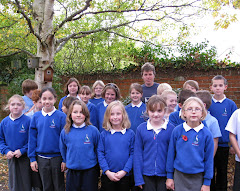Hi Sally,
It sounds like the children had a wonderful day on the island. Wish we could join them. Our Class had a great day at Shapwick last week doing some pond dipping. We found over 20 different species.
The children are busy doing their SATs this week but I will try to get them on-line soon.
Nina
Tuesday 12 May 2009
Monday 20 April 2009
Grand Anse EcoAride Club Visit Aride
On the last day of term over 30 children from the EcoAride Club at Grand Anse Primary School were given a real treat, courtesy of La Reserve Hotel. The club which meet every Tuesday during Extracurricular time have more members than ever this year and they are all keen to learn about Aride Island and its special wildlife. La Reserve kindly offered the use of their boat at a greatly reduced rate to enable the children to come out to the island and experience the wildlife first hand. So far they have only been able to hear about it from the Sally and teachers, or see and read about it from pictures and books, but last Friday they experienced it for themselves.

Close to the beginning of the breeding season, the children were greeted by flocks of sooty terns circling above the hill nosily, together with numerous pairs of fairy terns flying in formation as they dance over head, their white plumage perfectly lit up against the pure blue sky.



 Projects this year for the children back at school will include writing articles and poems about their day on Aride, creating a model of the island marking on where the different species of wildlife live, and writing an information panel on the history of the copra house that can still be seen on the island today, from the times when it was a coconut plantation. To do the latter they hope to conduct interviews with people that worked on Aride at the time.
Projects this year for the children back at school will include writing articles and poems about their day on Aride, creating a model of the island marking on where the different species of wildlife live, and writing an information panel on the history of the copra house that can still be seen on the island today, from the times when it was a coconut plantation. To do the latter they hope to conduct interviews with people that worked on Aride at the time.
So don’t forget to keep watching...

Close to the beginning of the breeding season, the children were greeted by flocks of sooty terns circling above the hill nosily, together with numerous pairs of fairy terns flying in formation as they dance over head, their white plumage perfectly lit up against the pure blue sky.

At this time of year especially, the island is a live with wildlife, and as young wildlife explorers the children were able to see young tropic birds at their feet, and fairy tern chicks at eye level.

Shearwater chicks snuggled into burrows and magpie robins came and fed on cleared ground in front of them, skinks and crabs played around their feet, the smell of the Wright’s Gardenia flower greeted them as they walked into the garden, geckos skulked on the trees protecting their eggs and lesser noddys croaked in unison as they walked along the paths.

They also found out about the social history of the island, about the Copra house and the Lodge and how the inhabitants used to use wooden boats to get supplies, not like the same inflatable ribs of today.  They learnt about island life, with no running water and at times no electricity, about the importance of the garden and of growing food especially for the times when the sea is too rough to launch the boat to get to Praslin. There was time for relaxing too, as the children had lunch in the visitors shelter and a chance to enjoy the sand fly free beach and the waves for which Aride is known.
They learnt about island life, with no running water and at times no electricity, about the importance of the garden and of growing food especially for the times when the sea is too rough to launch the boat to get to Praslin. There was time for relaxing too, as the children had lunch in the visitors shelter and a chance to enjoy the sand fly free beach and the waves for which Aride is known.
 They learnt about island life, with no running water and at times no electricity, about the importance of the garden and of growing food especially for the times when the sea is too rough to launch the boat to get to Praslin. There was time for relaxing too, as the children had lunch in the visitors shelter and a chance to enjoy the sand fly free beach and the waves for which Aride is known.
They learnt about island life, with no running water and at times no electricity, about the importance of the garden and of growing food especially for the times when the sea is too rough to launch the boat to get to Praslin. There was time for relaxing too, as the children had lunch in the visitors shelter and a chance to enjoy the sand fly free beach and the waves for which Aride is known. Projects this year for the children back at school will include writing articles and poems about their day on Aride, creating a model of the island marking on where the different species of wildlife live, and writing an information panel on the history of the copra house that can still be seen on the island today, from the times when it was a coconut plantation. To do the latter they hope to conduct interviews with people that worked on Aride at the time.
Projects this year for the children back at school will include writing articles and poems about their day on Aride, creating a model of the island marking on where the different species of wildlife live, and writing an information panel on the history of the copra house that can still be seen on the island today, from the times when it was a coconut plantation. To do the latter they hope to conduct interviews with people that worked on Aride at the time.So don’t forget to keep watching...
Thursday 2 April 2009
Pupils at Grand Anse Primary School choose the Environment
We had a great start to the new term here in Seychelles, it was excellent news to see that the Environmental Clubs for extracurricular studies proved to be one of the most popular with the young people of Grand Anse Primary School. In comparison to last year over double the number of children have signed up for the Eco-Aride club; totalling to an amazing 33 students.
 So far I have been working with the children in the Eco-Aride club looking at some of the amazing wildlife that is on the special island, from the sooty terns to the skinks, and the fairy terns too the frigate birds. The children have been learning about who eats who, by producing food webs and chains, and playing the food web game. Then there is adaptation, how special the fairy tern is, how they don’t build a nest but have extra long claws to hold on to the branch where it chooses to lay its egg.
So far I have been working with the children in the Eco-Aride club looking at some of the amazing wildlife that is on the special island, from the sooty terns to the skinks, and the fairy terns too the frigate birds. The children have been learning about who eats who, by producing food webs and chains, and playing the food web game. Then there is adaptation, how special the fairy tern is, how they don’t build a nest but have extra long claws to hold on to the branch where it chooses to lay its egg.
Last the week the group have started to build a model of the island for their school, through the model they will be able to show other pupils where the different wildlife lives. There are four main habitats on Aride; the sea, the beach, the plateau and the hill and the children will position which wildlife lives where and why.
All this work will be rewarded later this month as plans have been made for the group to come out to the island, where they will see all these things for real. This trip is being made possible by the generosity of La Reserve Hotel who is providing the use of their boat at a much subsidised rate so the children are able to benefit from their local environment and learn how special places like Aride are. With the provision of the boat it will mean that all 33 children and accompanying teachers will be able to make the trip. It will be excellent for the club to visit the island so early on in their studies as they will then be able to undertake a number of projects back at school based on what they have seen and learnt on the day.
Lots of projects are planned – so watch the bog to see how the day goes and news on what the Eco-Aride club is up to.
 So far I have been working with the children in the Eco-Aride club looking at some of the amazing wildlife that is on the special island, from the sooty terns to the skinks, and the fairy terns too the frigate birds. The children have been learning about who eats who, by producing food webs and chains, and playing the food web game. Then there is adaptation, how special the fairy tern is, how they don’t build a nest but have extra long claws to hold on to the branch where it chooses to lay its egg.
So far I have been working with the children in the Eco-Aride club looking at some of the amazing wildlife that is on the special island, from the sooty terns to the skinks, and the fairy terns too the frigate birds. The children have been learning about who eats who, by producing food webs and chains, and playing the food web game. Then there is adaptation, how special the fairy tern is, how they don’t build a nest but have extra long claws to hold on to the branch where it chooses to lay its egg.Last the week the group have started to build a model of the island for their school, through the model they will be able to show other pupils where the different wildlife lives. There are four main habitats on Aride; the sea, the beach, the plateau and the hill and the children will position which wildlife lives where and why.
All this work will be rewarded later this month as plans have been made for the group to come out to the island, where they will see all these things for real. This trip is being made possible by the generosity of La Reserve Hotel who is providing the use of their boat at a much subsidised rate so the children are able to benefit from their local environment and learn how special places like Aride are. With the provision of the boat it will mean that all 33 children and accompanying teachers will be able to make the trip. It will be excellent for the club to visit the island so early on in their studies as they will then be able to undertake a number of projects back at school based on what they have seen and learnt on the day.
Lots of projects are planned – so watch the bog to see how the day goes and news on what the Eco-Aride club is up to.
Friday 6 March 2009
Meare school bird watch
1 Blackbird
1 Blackheaded gull
2 Blue Tits
1 Chaffinch
2 Collared Doves
19 Crows
1 Great Tit
9 House Sparrows
1 Magpie
2 Pied Wagtails
1 Robin
100 Starlings
1 Blackheaded gull
2 Blue Tits
1 Chaffinch
2 Collared Doves
19 Crows
1 Great Tit
9 House Sparrows
1 Magpie
2 Pied Wagtails
1 Robin
100 Starlings
Monday 9 February 2009
Great Poems
Hey Children,
The poems about Ham Wall are great and really brought back memories of the Uk and the reserve.
Many thanks
Sally
The poems about Ham Wall are great and really brought back memories of the Uk and the reserve.
Many thanks
Sally
Sunday 8 February 2009
Big Garden Birdwatch on Aride Island
Hi Children
I hear that you recently did the RSPB Big Garden Birdwatch in school, well just for fun I thought I would do the same on the Aride and then you can compare the birds that I saw in an hour looking out of my imaginary window with yours!
My list goes like this:
1. Greater Frigate bird = 58
2. Fairy tern = 46
3. Bridled tern = 6
4. Sooty tern = 2
5. Turnstone = 6
6. Lesser noddy = 19
7. Brown noddy = 16
8. White-tailed tropic bird = 6
9. Seychelles magpie robin = 2
10. Seychelles warbler = 1
11. Seychelles sunbird = 2
12.Tok tok (Seychelles fody) = 5
13. Moorhen = 2
14. Blue pigeon = 5
15.Madagascar turtle dove = 1
16.Madagascar fody = 1
.png)
I hear that you recently did the RSPB Big Garden Birdwatch in school, well just for fun I thought I would do the same on the Aride and then you can compare the birds that I saw in an hour looking out of my imaginary window with yours!
My list goes like this:
1. Greater Frigate bird = 58
2. Fairy tern = 46
3. Bridled tern = 6
4. Sooty tern = 2
5. Turnstone = 6
6. Lesser noddy = 19
7. Brown noddy = 16
8. White-tailed tropic bird = 6
9. Seychelles magpie robin = 2
10. Seychelles warbler = 1
11. Seychelles sunbird = 2
12.Tok tok (Seychelles fody) = 5
13. Moorhen = 2
14. Blue pigeon = 5
15.Madagascar turtle dove = 1
16.Madagascar fody = 1
.png)
I have put some pictures of the birds down on the right hand side as they will all be new to you as none of them are found in the UK, by exception of the turnstone and moorhen, but the ones in the Seychelles are slightly different.
Have fun comparing
Best wishes
Sally
Thursday 5 February 2009
Ham wall cracker
hi sally this is a poem I wrote about ham wall.
Ham wall is...
The sound of rushing rivers,
a gentle breeze,
a land of ever-living.
Ham wall is...
The rythmic beating of wings,
a sky of pink cotton candy,
a magical new world.
Ham wall is...
Rain; like spiders creeping up my arms,
a blinding sunset,
the whispering wind.
By Charley Baker
from Meare school
Ham wall is...
The sound of rushing rivers,
a gentle breeze,
a land of ever-living.
Ham wall is...
The rythmic beating of wings,
a sky of pink cotton candy,
a magical new world.
Ham wall is...
Rain; like spiders creeping up my arms,
a blinding sunset,
the whispering wind.
By Charley Baker
from Meare school
Subscribe to:
Posts (Atom)
